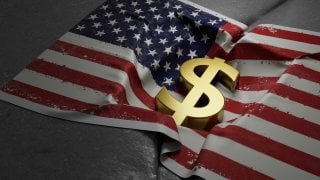America's $34.5-Trillion National Debt Is a Crisis in the Making
The national debt must be called out for what it is—one of the greatest home-grown threats to America.
On June 18, Joint Economic Committee (JEC) Vice Chair David Schweikert released the Republican Response to the Council of Economic Advisers’ 2024 Economic Report of the President. It warns that the national debt, $34.5 trillion and climbing, poses a risk to our economic growth and our ability to borrow for future needs—including national security demands in a crisis.
It is welcome to see policy leaders thinking through the implications, security and otherwise, of our massive national debt and deficit problem. When it comes to national security, the report is right to warn of the implications for our government’s ability to borrow to fund future contingencies. But the biggest risk related to our fiscal health is the harm debt problems do to our economy as a whole, the golden goose of our national power.
Unfortunately, we’re unlikely to hear about this subject during the presidential debate tonight. That’s because making necessary spending cuts and showing fiscal restraint is not what wins votes in our current political culture. But it is hard to blame politicians for responding to political incentives. To even have a chance at properly managing spending, rules need to be in place to limit how much politicians can spend and to require them to make cuts when necessary—and to do so without having to take specific, hard votes. This will give us some chance at saving our economic future and preserving our superpower status.
The JEC response discusses how maintaining status quo federal spending will make investors in U.S. Treasuries doubt that the government can pay its debts. As investors walk away from Treasury notes, the United States will face greater “economic instability” and the government will no longer be able to pay for budget deficits with debt. “These frictions in debt management,” the report warns, “would make it difficult to raise spending in response to a future global crisis, which has national security implications.” But we’d add that most importantly, if our fiscal policies and national debt harm our economic growth potential, America won’t have the kind of economy it takes to afford and maintain a strong national defense.
Former Joint Chiefs of Staff chairman Admiral Michael Mullen made the same warning fourteen years ago, and noted that national security is tied to the health of the economy. In short, this is because national defense is downstream from a prosperous economy. Economic growth, driven by private investment, allows us to afford high levels of defense spending. Plus, our technological edge in the private sector can be harnessed for military means. But if we kill the golden goose, we won’t have those eggs needed for our security.
When the government sells debt, private investors purchasing government debt to cover deficits come at the cost of whatever other projects those investors might have otherwise financed. As economist James Buchanan put it, spending that is funded by debt is “in effect chopping up the apple trees for firewood, thereby reducing the yield of the orchard forever.” Plus, there are foreign policy implications of seeking foreign purchasers for our debt.
Debt-financed spending also shifts tax burdens from present to future generations. While bond investors trust that their loan will be paid back with interest, future generations will bear the cost of the unproductive government spending from today. This will be paid for either through tax increases or by paying the debt off with surprise inflation, harming the purchasing power of ordinary Americans.
As the debt comes due, Admiral Mullen’s warnings come to fruition. We end up with weaker private investment, resulting in weaker innovation and missed opportunities to harness those innovations for defense purposes. Meanwhile, Americans will see higher tax rates as well as a weaker dollar and quickly realize that it pays more not to work. The less people produce, the weaker our economic growth, and the poorer we all become.
We would be pleasantly surprised to see our fiscal morass discussed in any serious way tonight because any politician’s top priorities are to get elected and to get reelected. Politicians win votes by promising to increase spending that will benefit key voter groups. For instance, both candidates have promised voters they will not touch Social Security or Medicare (the two largest spending categories). Unfortunately, not tackling the biggest spending issues also means financing this spending with debt.
Budget constraints like the Swiss Debt Brake can help get debt under control. This constitutional amendment would require government spending to keep pace with revenue, and limits spending growth to the average revenue growth over a multiyear period. While budget deficits can still occur when economic growth falls below projections, any debt taken on must be paid back with surpluses during booms. Since its enactment, Swiss Central government debt as a percentage of GDP has declined. From 2010-2021, while the U.S. national debt-to-GDP ratio exploded, the Swiss debt-to-GDP ratio hovered around 20 percent.
Another option is for the federal government to adopt a spending policy like the Department of Defense’s Base Realignment and Closure (BRAC) Commission. An outline for applying BRAC to the federal budget requires “silent approval.” Instead of a politician going on record in support of spending cuts, the spending cuts are enacted so long as the president and members of Congress do nothing. Instead, they must voice their disapproval to prevent spending cuts.
The national debt must be called out for what it is—one of the greatest home-grown threats to America. If you don’t believe us, believe Admiral Mullen.
About the Authors
William Ruger serves as the President of the American Institute for Economic Research. Follow him on X.com at @WillRuger
Thomas Savidge is a Research Fellow at the American Institute for Economic Research. Follow him on X.com at @thomas_savidge.
Image: Shutterstock.

